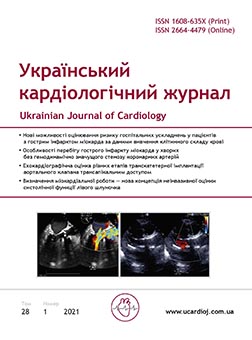Myocardial infarction with nonobstructive coronary arteries: clinical characteristics and features of the acute period
Main Article Content
Abstract
The aim – to define the clinical and anamnestic features of myocardial infarction, which determine the prognosis of patients with myocardial infarction with nonobstructive coronary arteries (MINOCA) in the acute period.
Materials and methods. The study included 33 patients with MINOCA (group I), and 73 patients with myocardial infarction (MI) with obstructive coronary artery disease (CAD) (group II) who were hospitalized in Clinical hospital # 8. Angiography, echocardiography, ECG, clinical laboratory tests were performed for all patients.
Results and discussion. As a result of a comparative analysis, it was found that the number of women in the group of patients with MINOCA (group I) was significantly higher than in group II (p=0.00001). The prevalence of risk factors such as hyperlipoproteinemia and smoking (p=0.0497; p=0.0096) in group I was lower than in group II. The average level of diastolic blood preasure in group I was significantly higher than in group II (p=0.002911). It was found that in the group I level of hemoglobin (p=0.003834), leukocytes (p=0.000376) and lymphocytes (p=0.003423) was significantly lower than in the group II, in group II diastolic dysfunction type I was prevailed (p=0.0084).
Conclusions. Study showed that women were more likely to have MINOCA than men. Proportion of patients with hyperlipidemia and smoking in the group I was lower than in the group II. Patients in the group I more likely had diastolic dysfunction, lower hemoglobin and leukocytes level than in patient with MI with obstructive CAD. Independent factors associated with the development of complications in the acute period of MINOCA were a decrease in diastolic blood preasure, an increase in systolic blood preasure and age (multivariate regression logistic analysis).
Article Details
Keywords:
References
Andrew S. Levey, Lesley A. et al. A New Equation to Estimate Glomerular Filtration Rate // Ann. Intern. Med.– 2009.– Vol. 150 (9).– P. 604–612. doi: https://doi.org/10.7326/0003-4819-150-9-200905050-00006.
Austen W.G., Edwards J.E., Frye R.L. et al. A reporting system on patients evaluated for coronary artery disease. Report of the Ad Hoc Committee for Grading of Coronary Artery Disease, Council on Cardiovascular Surgery, American Heart Association // Circulation.– 1975.– Vol. 51.– P. 5–40.
Bainey K.R., Welsh R.C., Alemayehu W. et al. Population-level incidence and outcomes of myocardial infarction with non obstructive coronary arteries (MINOCA): in sights from the Alberta contemporary acute coronary syndrome patients invasive treatment strategies (COAPT) study // Int. J. Cardiol.– 2018.– Vol. 264.– P. 12–17. doi: https://doi.org/10.1016/j.ijcard.2018.04.004.
Ibanez B., James S., Agewall S. et al. 2017 ESC Guidelines for the management of acute myocardial infarction in patients presenting with ST-segment elevation: The Task Force for the management of acute myocardial infarction in patients presenting with ST-segment elevation of the European Society of Cardiology (ESC) // Eur. Heart J.– 2018.– Vol. 39 (2).– P. 119–177. doi: https://doi.org/10.1093/eurheartj/ehx393.
Clarkson T.B. Estrogen effects on arteries vary with stage of reproductive life and extent of subclinical atherosclerosis progression // Menopause.– 2007.– Vol. 14 (3, Pt 1).– P. 373–384. doi: https://doi.org/10.1097/GME.0b013e31803c764d.
Neumann F.J., Sousa-Uva M., Ahlsson A. et al. ESC Scientific Document Group. 2018 ESC/EACTS Guidelines on myocardial revascularization // Eur. Heart J.– 2019.– Vol. 40 (2).– P. 87–165. doi: https://doi.org/10.1093/eurheartj/ehy394.
Niccoli G., Scalone G., Crea F. Acute myocardial infarction with no obstructive coronary atherosclerosis: mechanisms and management // J. Am. Heart Assoc.– 2012.– Vol. 1 (3).– P. e001388. doi: https://doi.org/10.1161/JAHA.112.001388.
Pasupathy S., Air T., Dreyer R.P. et al. Systematic review of patients presenting with suspected myocardial infarction and nonobstructive coronary arteries // Circulation.– 2015.– Vol. 131 (19).– P. e475. doi: https://doi.org/10.1161/CIRCULATIONAHA.114.011201.
Safdar B., Spatz E.S., Dreyer R.P. et al. Presentation, clinical profile, and prognosis of young patients with myocardial infarction with non obstructive coronary arteries (MINOCA): results from the VIRGO study // J. Am. Heart Assoc.– 2018. doi: https://doi.org/10.1161/JAHA.118.009174.
Scarabin-Carré V., Canonico M., Brailly-Tabard et al. High level of plasma estradiol as a new predictor of ischemic arterial disease in older postmenopausal women: the three-city cohort study // J. Am. Heart Assoc.– 2012.– Vol. 1 (3).– P. e001388. doi: https://doi.org/10.1161/JAHA.112.001388.
Tamis-Holland J.E., Jneid H., Reynolds H.R. et al. Citation: Contemporary Diagnosis and Management of Patients With Myocardial Infarction in the Absence of Obstructive Coronary Artery Disease: A Scientific Statement From the American Heart Association // Circulation.– 2019.– Vol. 139 (18).– P. e891–e908. doi: https://doi.org/10.1161/CIR.0000000000000670.
Thygesen K., Alpert J.S., Jaffe A.S. et al. ESC Scientific Document Group; Fourth universal definition of myocardial infarction Fourth Universal Definition of Myocardial Infarction // J. Am. Coll. Cardiol.– 2018.– Vol. 72 (18).– P. 2231–2264. doi: https://doi.org/10.1016/j.jacc.2018.08.1038.
Tremblay A.J., Morrissette H., Gagné J.M. et al. Validation of the Friedewald formula for the determination of low-density lipoprotein cholesterol compared with beta-quantification in a large population // Circulation.– 2019.– Vol. 139, Issue 18.– P. e891–e908. doi: https://doi.org/10.1161/CIR.0000000000000670.
Vidal-Petiot E., Ford I., Greenlaw N. et al. CLARIFY Investigators. Cardiovascular event rates and mortality according to achieved systolic and diastolic blood pressure in patients with stable coronary artery disease: an international cohort study // Lancet.– 2016.– Vol. 388 (10056).– P. 2142–2152. doi: https://doi.org/10.1016/S0140-6736(16)31326-5.


